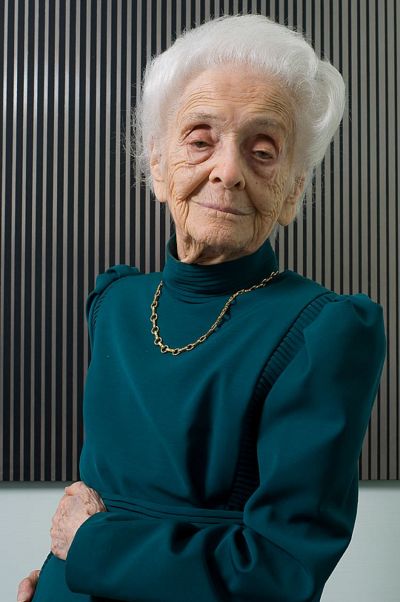This month we have just emerged from awards season, that period between November and February when all the rich and famous people congratulate one another. The Grammy Awards. The American Music Awards. The People’s Choice Awards. And, of course, the big Kahuna, The Academy Awards. It almost seems there is a television special for one of them every week. However, the most prestigious of all awards is not televised, The Nobel Prize. People are not awarded the Nobel for play-acting, or singing, or designing costumes. Nobel Prize recipients are those who, during the preceding year, have conferred the greatest benefit on mankind.
As of this writing, there have been 21 Italian Nobel prize winners in fields ranging from physics to literature. However, the Nobel Prize winner for whom I have the greatest admiration is Rita Levi-Montalcini. Despite being faced with obstacles that would have ended the careers of others, Dr. Levi-Montalcini pressed forward.
Rita Levi-Montalcini and her twin sister, Paola, were born in Turin on April 22, 1909 to an Italian-Jewish family whose roots reportedly extend back to the Roman Empire. Although both her parents were educated and cultured, encouraging intellectual pursuits, they still held typical Victorian values. These values mandated that the husband and father, the head of the household, made all the decisions while the wife dedicated herself to the responsibilities of the home and motherhood. Although Levi-Montalcini tells us that her father loved his daughters dearly and greatly respected women, he was still a product of his times. As a result, he did not educate his daughters to prepare them for any professional career. In Levi-Montalcini’s youth, her father’s attitude was not much of an issue since she considered becoming an author. However, after seeing her governess die of stomach cancer, she decided to become a doctor.
Levi-Montalcini describes the first challenge she faced, “at 20, I realized that I could not possibly adjust to a feminine role as conceived by my father and asked him permission to engage in a professional career.” After much convincing, her father reluctantly agreed. She then faced her second hurdle, overcoming her lack of education. After learning in a few months the necessary Greek, Latin, and mathematics, which took others years, she attended the University of Turin Medical School. Amazingly, in 1936, she graduated summa cum laude with a degree in Medicine and Surgery. Nonetheless, after graduation, she was unsure whether to dedicate herself solely to the medical profession or pursue basic neurological research. She decided to stay at the university, working as an assistant to Giuseppe Levi, the neurohistologist who had sparked her interest in the developing nervous system.
Levi-Montalcini’s career took a turn in 1938 when Mussolini issued the Manifesto for the Defense of the Race. The laws that followed this proclamation forbade non-Aryan Italians from academic or professional careers. Forced to leave her work at the university, she relocated to Belgium until the Germans invaded. Returning to Turin, she and her family lived without connection to the Aryan world. After constructing a small research unit in her home, she continued her work, relocating yet again to a cottage in the country when the allied bombing made it unsafe to stay in the city. When the Nazis invaded Italy in 1943, she and her family fled to Florence, where they lived underground until the war’s end. Levi-Montalcini said of this experience, “I should thank Mussolini for having declared me to be of an inferior race. This led me to the joy of working, not any more unfortunately in university institutes but in a bedroom.”
After the war, in 1946, when her hidden research came to light, Viktor Hamburger, German-American embryologist, asked her to join him at Washington University in St. Louis, Missouri. There, she and Hamburger discovered a substance in tumors they named Nerve Growth Factor (NGF) that spurred nerve growth. NGF has given scientists a new understanding of neural growth, enabling them to battle dementia, Alzheimer’s, and other neural degenerative disorders. In addition, NGF can be beneficial in treating cancer, multiple sclerosis, and such psychiatric disorders as schizophrenia and autism. For this work, in 1968, she was awarded the Nobel Prize in the Physiology of Medicine.
From 2001 until she died in 2012, Levi-Montalcini served in the Italian Senate as a Senator for Life, an honor bestowed by the president of the Italian Republic for outstanding patriotic merits in the social, scientific, artistic, or literary field. After having faced so many personal challenges, Levi-Montalcini used this position to support other scientists. For example, in 2006, she was able to reverse the Italian government’s decision to cut scientific funding.
Beyond her work as a senator, in 2002 she founded the European Brain Research Institute in Rome. The Institute is internationally recognized for its brain research and the development of new therapeutic approaches for neurological and psychiatric disorders. She also established the Levi-Montalcini Foundation, whose mission is to support education and schooling, in all of its forms, for children, girls, and women in Africa.
Rita Levi-Montalcini lived an inspirational life. Overcoming the barriers erected against someone of her gender and faith, she used her genius for the betterment of all. Yet, she continued to give back, aiding others who are targets of discrimination. Rita Levi-Montalcini, a truly admirable Italian.



